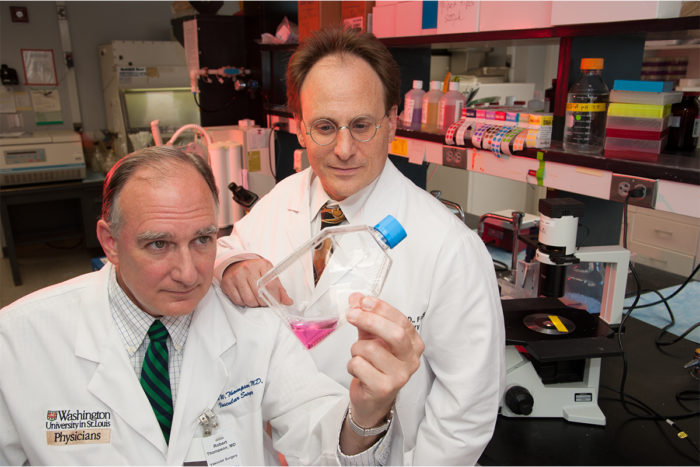New study monitors abdominal aortic aneurysms growth
A national trial is evaluating an antibiotic as a non-surgical method to control the growth of aneurysms, or enlargements, of the abdominal aortic artery

Robert Thompson, MD and John Curci, MD are involved in a national trial to test whether an antibiotic could provide a non-surgical way to control the growth of abdominal aortic aneurysms.
Standard care for patients with small abdominal aortic aneurysms, or enlargements of the abdominal aortic artery, has been to watch and wait until the aneurysm grows to 5.5 centimeters in diameter—the threshold at which surgery must be performed to prevent rupture.
The N-TA3CT clinical trial, funded by the National Institutes of Health (NIH), may alter this “wait-and-watch” approach as researchers at 15 institutions across the country test the effectiveness of an inexpensive and widely available drug as a non-invasive treatment.
Antibiotic instead of surgery
The antibiotic doxycycline is being tested as a means to slow the growth of these aneurysms to the point that surgery may be avoided altogether, according to John Curci, MD, assistant professor of surgery at Washington University and co-principal investigator in the N-TA3CT clinical trial.
“Although doxycycline is an antibiotic, it also blocks enzymes that can damage the aortic wall,” said Curci. “We anticipate that treatment with this drug could slow the aneurysm’s growth so that the need for surgery never becomes an issue in a patient’s natural life.”
More than a decade of basic research studies from the labs of Curci and Robert Thompson, MD, professor of surgery at Washington University, helped contribute to the discovery and development of doxycycline as a possible treatment option, according to Curci.
“It’s very exciting to see work that we’ve done in the lab result in a study that may positively affect patients’ lives,” said Curci.
N-TA3CT clinical trial enrollment began in March 2012. Participants must be at least age 55 and have an abdominal aortic aneurysm measuring 3.5 centimeters to 5 centimeters in diameter. Thompson serves as the site principal investigator at Washington University.






